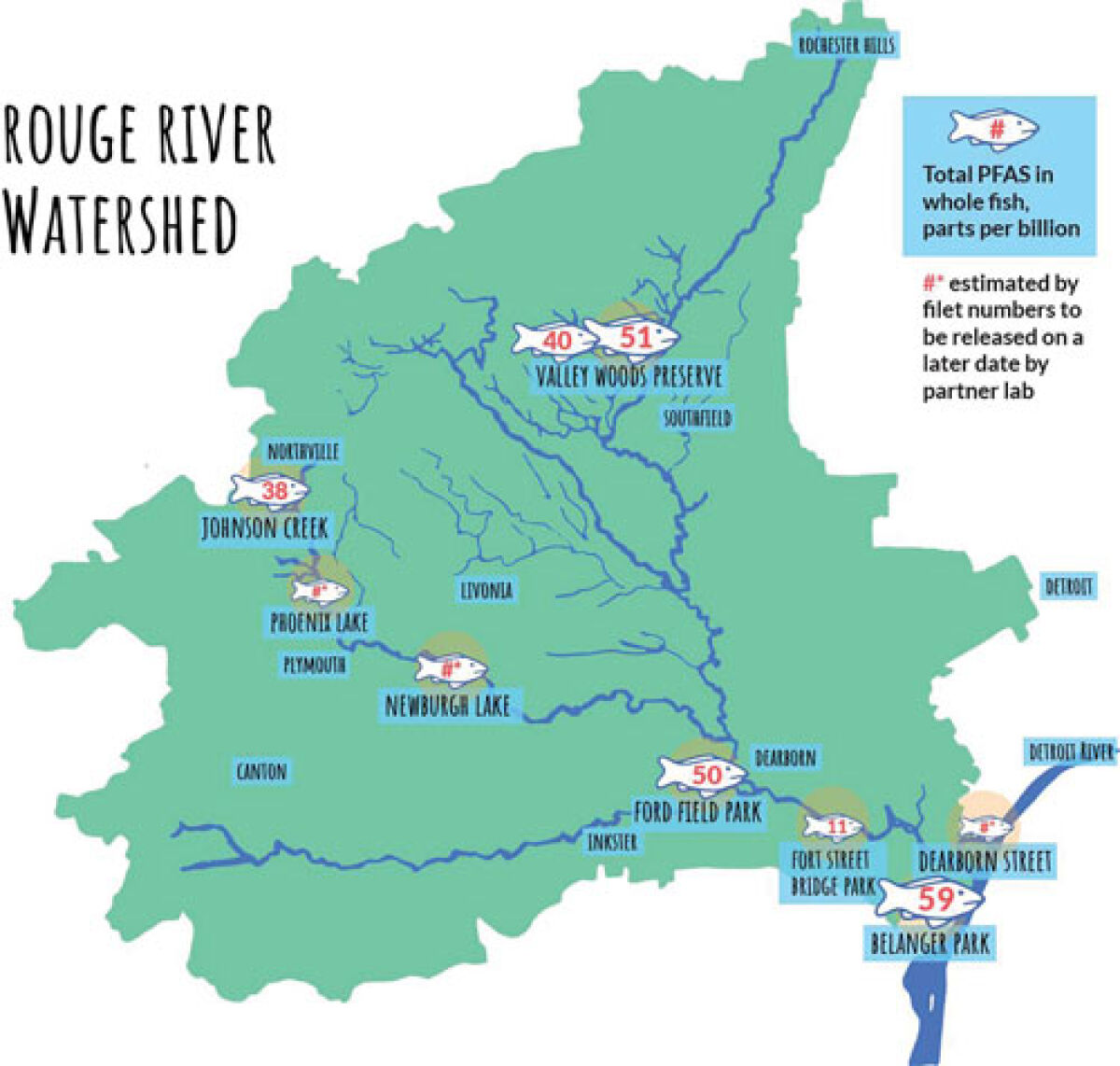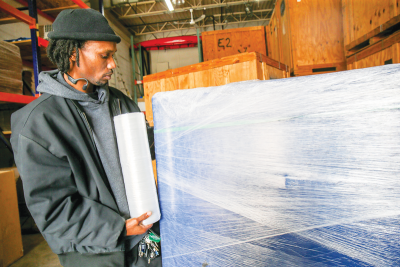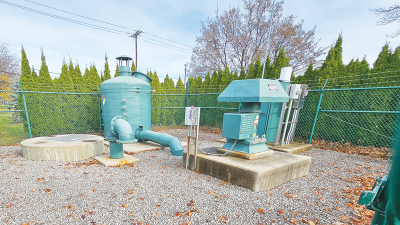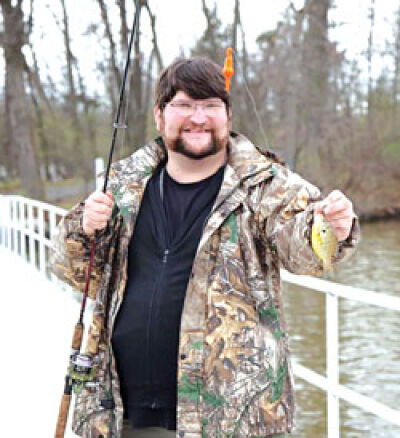
Another one of the six anglers, Jerrad Jankowski, refers to himself as a “fishing addict.”
Photo by the Friends of the Rouge River
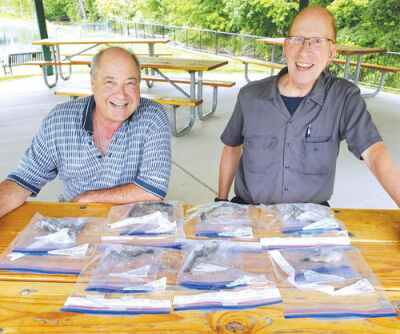
Bill Bialkowski poses with Phil, a friend of his who he convinced to join the study, and some of the fish they collected.
Photo by Bill Bialkowski
SOUTHFIELD — With the help of six anglers, the Ecology Center, the Huron River Watershed Council and the Friends of the Rouge set out in summer 2022 to deepen their understanding of which parts of the fish PFAS chemicals are accumulating and where in the watersheds PFAS is concentrating.
Many of the anglers involved in the study would eat what they caught. One of the six anglers, Jerrad Jankowski, of Clinton Township, describes himself as a “fishing addict.” Jankowski keeps a rod and some gear in the back of his truck, so he’s prepared to go fishing whenever the mood strikes. Fishing has been a lifelong hobby for Jankowski, and part of the fun for him is saving some of what he catches to have a fish fry with his friends and family.
“Seeing how many lakes have been poisoned with this stuff, even the lakes we thought would be clean or have minimal levels was heartbreaking, and looking at the data, it’s very eye-opening,” Jankowski stated.
PFAS stands for perfluoroalkyl and polyfluoroalkyl substances, which the Ecology Center describes as “a class of thousands of toxic chemicals widely used in manufacturing and consumer products.”
PFAS is used to make products resistant to water, oil and stains. However, the danger of PFAS is that it does not break down in the environment, meaning that PFAS pollution in bodies of water leads to contamination of fish, which is especially dangerous for subsistence anglers who consume what they catch. PFAS chemicals are linked to certain types of cancers, reproductive issues and reduced vaccine effectiveness.
Using a community-based science model, the project approached six anglers who went through a training session to learn how to properly package the fish they caught without contaminating the samples. The anglers took part in designing the research questions, collecting samples, processing the fish, and discussing the results and education strategies for fellow anglers.
From April to June, the anglers were given a choice of 15 locations to fish around the Rouge River and Huron River. Over 100 fish of 12 different species — such as bluegill, pumpkinseed, rock bass and catfish — were tested for 40 different PFAS chemicals. The fish were put into a freezer and transported to Envirolab in Oscoda, Michigan, where they were blended together so that scientists could test the entire fish, rather than just the fillet, which was the previous protocol used in 2018 when the Huron River was contaminated by a chrome plating facility that manufactures shiny coatings on car parts.
The results were devastating.
PFAS chemicals were found in every single fish tested from both rivers.
Fourteen different types of PFAS chemicals were detected in the study, with each fish containing at least one of the 14 chemicals.
Of these 14 chemicals, only two are regulated in Michigan. Perfluorooctane sulfonic acid, or PFOS, is one of the few regulated PFAS chemicals widely found because it doesn’t break down. PFOS was found in 58% of the Huron fish and in 46% of the Rouge fish. The range of PFAS found in the whole fish was 11 to 59 parts per billion (nine fish) in the Rouge River and 12 to 133 parts per billion (11 fish) in the Huron River. The estimated highest filet concentrations were 47 ppb for the Huron and 12 ppb for the Rouge.
Though these results yielded lower levels of PFAS in Huron River fish than in the 2018 testing, these levels are above what the state of Michigan advises, limiting consumption to two Huron and 12 Rouge meals per month. Currently, the state has issued a “Do Not Eat” advisory if PFOS is found at greater than 300 ppb in fish.
“We got this survey started, and halfway through, the Health Department issued a ‘Do Not Eat’ advisory because they found some really high levels,” said Sally Petrella, the monitoring manager at Friends of the Rouge who worked closely on the study. “It really hit home for me that we had these anglers out here collecting fish to be tested, and we’re already getting a fish consumption advisory showing us how important it is to be collecting this information and understand how deep the problem is so we can work to fix it.”
Petrella stated that the EPA recently proposed the first-ever national drinking water standard, the National Primary Drinking Water Regulation, which would require the public water systems to monitor, notify the public of the levels and reduce the levels in drinking water if they exceed the proposed standards of six types of PFAS:
• perfluorooctanoic acid (PFOA).
• perfluorooctane sulfonic acid (PFOS).
• perfluorononanoic acid (PFNA).
• hexafluoropropylene oxide dimer acid (HFPO-DA).
• perfluorohexane sulfonic acid (PFHxS).
• perfluorobutane sulfonic acid (PFBS).
The EPA aims to finalize the regulation by the end of 2023. If fully implemented, the EPA estimates “the rule will prevent thousands of deaths and reduce tens of thousands of serious PFAS-attributable illnesses.”
Another angler involved in the study, Bill Bialkowski, of Dearborn, is a retired accountant who took up fishing as a hobby because it was a way for him to connect with nature and other anglers. Bialkowski found himself involved in the study when he ran into Petrella at the 2022 End of Winter Paddle. He approached Petrella and asked if there were any upcoming projects that he’d be able to participate in. A few weeks later, she contacted him about the upcoming PFAS study seeking local anglers to participate.
“I quite enjoyed it, because I fish for fun anyways,” Bialkowski said. “He explained that throughout the study, he began to read up on PFAS chemicals so that he could educate anyone who asked him about his involvement in the study.
“I’m not any kind of a true scientist, but this role as ‘Citizen Scientist,’ I really liked it, and it’s become one of my hobbies starting this year.”
Bialkowski stated that he is eager to participate in the Friends of the Rouge’s upcoming Frog and Toad Survey, which takes place from March through July.
For the Rouge River, PFAS testing had been limited up until this point, and prior to this study, PFAS levels in fish were not high enough to warrant any fish consumption advisories.
However, as Petrella mentioned, the Michigan Department of Health and Human Services issued an advisory for certain fish, such as bluegill and sunfish, due to the high levels of PFOS found in them in the lower branch and the main branch, from the Ford Estate dam to the Detroit River. Additionally, unlike the Huron River, a pollution source has not been identified.
The EPA advises that there are no safe levels of PFAS in drinking water, yet Michigan’s fish consumption levels have not been updated to reflect this data. The Ecology Center, the Friends of the Rouge and the Huron River Watershed Council are advocating for stricter advisories and plead for Michigan lawmakers to establish “science-based PFAS maximum contaminant levels for fish and wildlife, increase consumption advisory signage in heavy fishing areas along the Huron and Rouge rivers, include other PFAS chemicals in addition to PFOS in the Eat Safe Fish Advisory, and take a proactive stance and prevent future pollution in Michigan fisheries, water and wildlife by regulating new chemical threats to ecosystems, prohibit the sale of all PFAS-containing products except when no safer alternative exists and to hold polluters financially responsible for cleaning up PFAS pollution, including mitigation and PFAS destruction.”
U.S. Sen. Gary Peters announcing new bipartisan legislation to help protect consumers from toxic perfluoroalkyl and polyfluoroalkyl substances March 16.
The Protecting Consumers from PFAS Act would add the Consumer Product Safety Commission to the list of federal agencies required to participate on the PFAS Interagency Working Group, which Peters helped establish in 2021 to improve coordination between federal agencies to address PFAS contamination, according to a press release. The commission is tasked with protecting the public against injury or harm associated with consumer products, such as water-resistant clothing, nonstick cookware, and other products that may contain PFAS chemicals “which can lead to serious health effects including cancer, low infant birthweight, liver and kidney issues, and reproductive and developmental problems,” the release states.
“Toxic PFAS chemicals have been found in our everyday items from clothing to non-stick cookware to cleaning supplies to dental floss,” said Peters. “I’m leading this bipartisan bill to ensure the federal agency responsible for protecting consumers from products that threaten their health and safety has a seat at the table as we work to address and eliminate these dangerous toxins.”
The bill reportedly builds on Peters’ efforts to address PFAS contamination, according to the release. In a funding bill signed into law in December 2022, Peters pushed for continued efforts to address PFAS contamination. The law included $5 million for the U.S. Department of Agriculture to support efforts to address PFAS contamination in agriculture, $2.7 million for the U.S. Geological Survey to conduct research on the transmission of PFAS substances in watersheds and aquifers, and $2 million for the National Institute of Environmental Health Sciences to continue work on PFAS and other contaminants of concern.
To learn more about this study, visit https://www.ecocenter.org/our-work/healthy-stuff-lab/reports/community-based-study-pfas-fish.
For more information regarding the EPA’s National Primary Drinking Water Regulation, visit https://www.epa.gov/sdwa/and-polyfluoroalkyl-substances-pfas.
 Publication select ▼
Publication select ▼